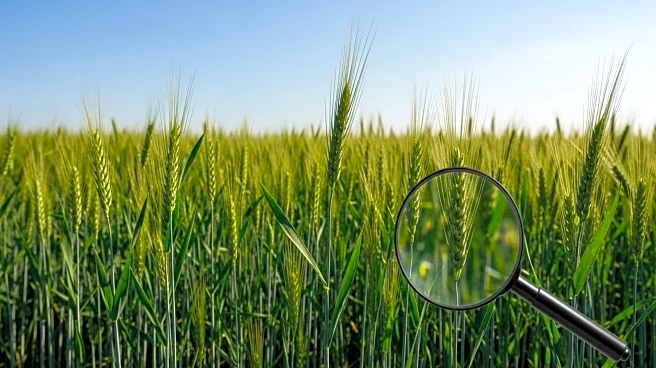What is the story about?
What's Happening?
A recent study has identified two complementary NLR genes from wild emmer wheat that confer resistance to powdery mildew, a common fungal disease affecting wheat crops. The research focused on the genetic mapping of the resistance gene MlIW39, which was derived from a specific wheat accession. The study involved fine mapping and genetic analysis to pinpoint the location of MlIW39 on the wheat genome, revealing its association with two NLR genes. These genes, named MlIW39-R1 and MlIW39-R2, were found to work cooperatively to provide resistance against multiple isolates of the powdery mildew pathogen. The study also explored the structural characteristics and interactions of these NLR proteins, suggesting their potential role in plant immune responses.
Why It's Important?
The discovery of genetic resistance to powdery mildew in wheat is significant for agriculture, particularly in the U.S., where wheat is a major crop. Powdery mildew can cause substantial yield losses, and the identification of resistance genes offers a pathway to developing more resilient wheat varieties. This could lead to reduced reliance on chemical fungicides, promoting more sustainable farming practices. The study's findings may also contribute to broader efforts in plant breeding and genetic engineering, enhancing food security and agricultural productivity.
What's Next?
The next steps involve further validation of the identified NLR genes through transgenic experiments and breeding programs. Researchers aim to incorporate these resistance genes into commercial wheat varieties, potentially improving their resilience to powdery mildew. Additionally, ongoing studies will focus on understanding the molecular mechanisms underlying the resistance conferred by these genes, which could lead to new strategies for managing fungal diseases in crops.
Beyond the Headlines
The study highlights the importance of genetic diversity in wild plant species as a source of valuable traits for crop improvement. It underscores the potential of using advanced genetic mapping and molecular biology techniques to address agricultural challenges. The findings may also stimulate interest in exploring other wild relatives of crops for similar resistance traits, contributing to the development of more robust agricultural systems.
AI Generated Content
Do you find this article useful?















